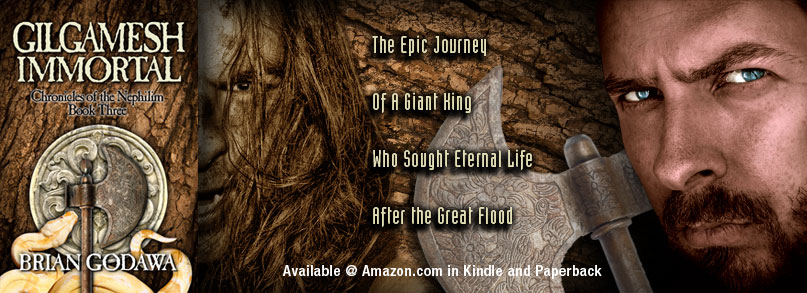
Noah is a hot topic these days because of the movie with Russell Crowe. Here is some research I’ve done to add to that conversation.
I’ve written a Biblical fantasy novel called Noah Primeval. I’ve researched this topic extensively. Noah Primeval has been a category bestseller on Amazon for 3 years. It’s first in a series of novels called Chronicles of the Nephilim.
Down and Dirty Comparison of Genesis with Gilgamesh
In the previous post, I introduced the issue of the Epic of Gilgamesh and it’s parallel with the Noah story in Genesis. Now, let’s take a closer look.
Biblical scholar Gordon Wenham has listed seventeen major correlations between the Genesis Flood and the Gilgamesh Deluge that indicate a strong genetic connection between the two narratives:
1. Divine decision to destroy
2. Warning to flood hero
3. Command to build ark
4. Hero’s obedience
5. Command to enter
6. Entry
7. Closing door
8. Description of flood
9. Destruction of life
10. End of rain, etc.
11. Ark grounding on mountain
12. Hero opens window
13. Birds’ reconnaissance
14. Exit
15. Sacrifice
16. Divine smelling of sacrifice
17. Blessing on flood hero (1)
These similar details clearly show a common source connection. From where, it is not certain. But Alexander Heidel’s classic The Gilgamesh Epic and Old Testament Parallels has teased out the differences between the two that shed light on their radically divergent meanings regarding the cause of the Flood and the possibility of redemption for humanity. (2)
In Gilgamesh, the gods send the Deluge because of an undefined sin of mankind (Tablet XI:180). Utnapishtim lies to his neighbors about the ark because the gods do not want man to know what they are about to do.
Contrarily, in Genesis, the Flood is very clearly a righteous judgment upon an earth that was “corrupted and filled with violence.” “The LORD saw that the wickedness of man was great in the earth, and that every intention of the thoughts of his heart was only evil continually.”
God gives man a “period of grace” of one hundred and twenty years with which to repent and obey God (Gen 6:5-6). Though this purpose is not stated explicitly in Genesis, another passage in the New Testament seems to indicate this notion of God providing such opportunity.
1 Peter 3:19–20
[In the spirit] he went and proclaimed to the spirits in prison, because they formerly did not obey, when God’s patience waited in the days of Noah, while the ark was being prepared, in which a few, that is, eight persons, were brought safely through water.
Surely, there is an assumption, sometimes explicit, but always implicit throughout the Old Testament that if man repents, God will stay his hand of planned judgment.
The ark also provides an example of significant difference between the narratives. The length of Noah’s ark was 450 feet long, 75 feet wide, and 45 feet high, with a displacement of approximately 43,300 tons. It had three levels to contain the animals, that on the surface of the account is structurally feasible.
Utnapishtim’s vessel however, was not so amiable to reality. According to Babylonian measurements, it was supposed to be a square cube of 200 feet on all sides and was divided into seven levels, displacing approximately 228,500 tons, making it a rather questionable sea worthy craft. (3)
In the Biblical story, it is well known that the flood began with rain coming down from the heavens and waters coming up from the deep. The rain storm lasted 40 days and 40 nights, and then after 150 days, the waters began to abate until the earth was dry enough to leave the ark about 360 days or 1 year after the start of the flood.
In the Babylonian versions, the flood storm lasts only 7 days and 7 nights, followed by an unspecified number of days for the waters to dry up before Noah leaves the ark.
Upon leaving the boat, Utnapishtim and Noah both build altars and offer sacrifices of thanksgiving and appeasement unto their gods. But the theological incongruity between the accounts is spelled out in the divine reactions.
In Gilgamesh, “The gods smelled the savour, the gods smelled the sweet savour, the gods gathered like flies around the sacrificer” (Tablet XI:161-163). Of this passage, Andrew George writes,
The simile used to describe the gods’ arrival is famously the image of hungry flies buzzing around a piece of food. This imagery implies a somewhat cynical view of gods, even more disrespectful than the earlier simile likening them to cowering dogs. (4)
Enlil then starts to quarrel with Enki for revealing the secret to Utnapishtim, wherein Enki defends himself with trickery by arguing that he did not reveal it directly to Utnapishtim, but through a dream, thus freeing him from blame.
Contrary to the Babylonian zoomorphic simile of the gods, the Bible engages in anthropomorphism (human-like) in that man is created in the image of God and thus sacrifice is understood in the priestly terms of atonement for sin (Lev. 1:9). God “smelled the pleasing aroma, the LORD said in his heart, ‘I will never again curse the ground because of man (Gen. 8:21).’” Heidel explains
The propitiatory character of the sacrifice is brought out quite clearly in the biblical narrative, where the ascending essence of the burnt-offerings is called a “soothing odor,” or, literally, an “odor of tranquilization.” One purpose of Noah’s sacrifice, as seems to be indicated by what follows, probably was to appease the wrath of God which had been kindled by the sins of mankind and which Noah had just witnessed. But at the same time it was undoubtedly an offering for the expiation of his own sins and those of his family. (5)
Whereas the Babylonian anthropomorphic descriptions of their deities tended to reflect human weaknesses (hunger) and sin (quarreling), the Biblical account depicts the human-like character traits of God in terms of relationship (propitiation and atonement).
In the Babylonian versions, Noah and his wife are blessed with eternal life after Enlil gives in to Enki’s defensive arguments. They are then taken to a distant place, “at the mouth of the rivers,” probably referring to the Persian Gulf, into which the Euphrates and Tigris rivers opened up.
The Biblical version is theologically motivated by God’s covenantal nature. God blesses Noah, and then grants him the original charge given to Adam to multiply and fill the earth, and to exercise dominion over the creatures (Gen 9:1-3). As the flood was a return to the chaos waters before creation, so the world of Noah is a new creation with a new Adam. And God reinforces his value of the created image of God in man, by bringing special attention to capital punishment for murdering man, made in the image of God.
The rainbow becomes God’s covenant promise to stay his hand from Deluge judgment, unlike the Gilgamesh Epic, that has a secondary mother goddess claim that a necklace strung with flies will, “remind her of the hungry gods buzzing around [Utnapishtim’s] sacrifice, and ultimately of her special responsibility to her human children” (6)(Tablet XI:165-169).
Comparison and Contrast
The value of comparative religion lies in achieving a better understanding of the historical and cultural context of ancient writings like the Bible. Too often, both religious believers and unbelievers approach the text with their own preconceived modern worldview or political agenda that they project upon the text in order to “use” it for their own purposes, positive or negative.
Christians have been guilty of forcing poetic passages into the straightjacket of a hyper-literalistic hermeneutic, or imposing our notions of historical accounting or scientific accuracy upon ancient writers who just did not write with our post-Enlightenment modern scientific or historical worldview.
But it works the other way as well. Modern notions of literary evolution get imposed upon the Bible by detractors who wish to discredit the narrative by reducing it to one of a variety of myths that evolve over time. This modern prejudice also ignores the polemical thrust of much ancient literature that interpreted historical events with divergent meanings, or engaged in retelling narratives through contrary theological lenses. This is not the syncretism of evolutionary plagiarism, but the subversion of worldview polemics.
Buy the novel Noah Primeval, here on Amazon.com in Kindle or paperback. The website www.ChroniclesOfTheNephilim.com has tons of way cool free videos, scholarly articles about Watchers and Nephilim Giants, artwork for the series, as well as a sign-up for updates and special deals.
FOOTNOTES
1. Gordon J. Wenham, “The Coherence of the Flood Narrative,” Vetus Testamentum 28, no. 3 (1978), p. 346.
2. Alexander Heidel, The Gilgamesh Epic and Old Testament Parallels, Chicago, IL: University of Chicago, 1946, 1963, p. 230-232.
3. Heidel, The Gilgamesh Epic, pp. 232-236.
4. .R. George, The Babylonian Gilgamesh Epic: Introduction, Critical Edition and Cuneiform Texts, Vol. 1, Oxford University Press, 2003, pp. 518.
5. Heidel, The Gilgamesh Epic, p. 255.
6. George, The Babylonian Gilgamesh Epic, pp. 518.



One comment on “Noah Facts #9: Round 2 – Noah Vs. Gilgamesh Smackdown!”
Comments are closed.